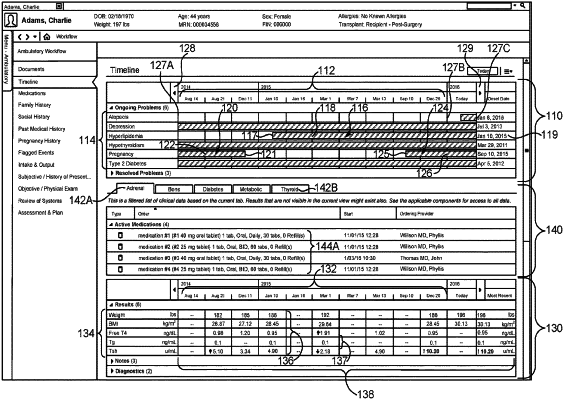| CPC G16H 10/60 (2018.01) [G06F 16/338 (2019.01); G06F 16/345 (2019.01); G16H 15/00 (2018.01); G16H 50/20 (2018.01); G16H 50/50 (2018.01)] | 20 Claims |

|
1. A system for configuring clinically relevant data to maintain trend context when displayed on a user interface, the system comprising:
at least one processor of a computing system;
the user interface in communication with the at least one processor; and
one or more computer-readable storage devices storing instructions that, when executed by the at least one processor, cause the at least one processor to:
retrieve patient information for a patient from a plurality of data sources having different data formats, wherein the patient information includes diagnostic events and relevant dates associated with each diagnostic event;
generate a user interface on a display screen;
generate a first timeline area on the display screen in the user interface, wherein the first timeline area is generated to have a horizontal size based on at least a size of the display screen;
generate a horizontal timespan presented horizontally between a first boundary and a second boundary within the first timeline area and including a set of non-linear dates;
wherein the set of non-linear dates of the horizontal timespan is determined from at least a portion of the relevant dates corresponding to the diagnostic events from the patient information,
the set of non-linear dates being provided in chronological order and spaced apart by an equal distance to form the non-linear timeline,
display vertically, within the first timeline area, a set of clinical diagnoses based on the diagnostic events, and
generate and display a duration indicator associated with a clinical diagnosis of the set of clinical diagnoses, the duration indicator having an onset date end associated with an onset date of the clinical diagnosis and a duration region beginning at the onset date end and extending horizontally therefrom to an end date determined from the relevant dates;
wherein the horizontal timespan includes a non-fixed area that is configured to be manipulated by a user input on the user interface; and
in response to the user input, automatically expanding or compressing the horizontal timespan to change the set of non-linear dates that are displayed in the horizontal timespan that causes the associated duration regions of the duration indicators to expand or compress based on the set of non-linear dates that are displayed.
|